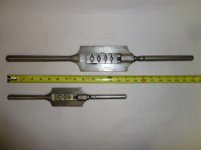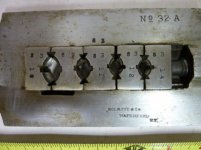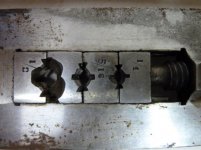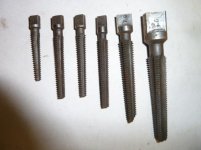Believe they're late 1800s. Uncleaned, touch of light rust. PM me if interested.
The Holroyd & Co #32A has 6 taps #10,11,12L,13,14,14L, measuring 2-3/4" - 4-5/8"L. It's box lid is split, but solid. Assembled handle is @22"L.
The JM King & Co #41 has 6 taps (3)16,18,(2)20, measuring 1-5/8" - 3-3/4"L. Assembled handle is @14"L. The face of 1 die is chipped, but teeth are present.
The Holroyd & Co #32A has 6 taps #10,11,12L,13,14,14L, measuring 2-3/4" - 4-5/8"L. It's box lid is split, but solid. Assembled handle is @22"L.
The JM King & Co #41 has 6 taps (3)16,18,(2)20, measuring 1-5/8" - 3-3/4"L. Assembled handle is @14"L. The face of 1 die is chipped, but teeth are present.











